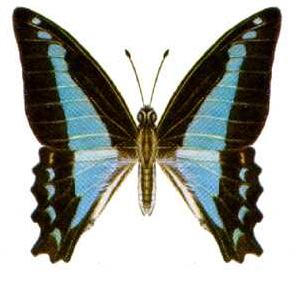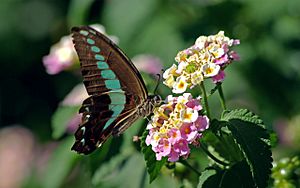Common bluebottle facts for kids
Quick facts for kids Common bluebottle |
|
|---|---|
 |
|
| Graphium sarpedon choredon | |
| Scientific classification | |
| Kingdom: | |
| Phylum: | |
| Class: | |
| Order: | |
| Family: | |
| Genus: | |
| Species: |
G. sarpedon
|
| Binomial name | |
| Graphium sarpedon |
|
The Common bluebottle (Graphium sarpedon) is a beautiful type of swallowtail butterfly. You can find it in parts of South Asia, Southeast Asia, and Australia. There are 15 different kinds, called subspecies, that live in various places around the world.
Contents
What Does the Common Bluebottle Look Like?
The top side of this butterfly's wings is a deep black color. Both its front and back wings have a wide, pale blue band crossing them. This band can look a bit green towards the front of the wing. On the back wings, there's also a line of thin blue crescent shapes near the edge.
The underside of the wings is dark brown. The back wings have some special markings. There's a short, wide black band near the base. The area between the blue band and the blue crescent shapes is velvety black with thin crimson (red) lines. You might also see a crimson spot near the bottom corner of the back wing.
Male bluebottles have a special fold on their abdomen with a tuft of stiff white hairs.
There's a specific type of Common bluebottle called teredon found in South India and Sri Lanka. These butterflies have a narrower blue band on their wings. Their colors are brighter, and the blue and green parts of the band stand out more. Their back wings are also a bit more pointed at one spot.
Common bluebottles usually have a wingspan (the distance from one wingtip to the other) between 55 and 75 millimeters. Their upper wings are black, and their lower wings are brown. Both sets of wings have a central blue or blue-green triangle shape.
Where Do Common Bluebottles Live?
Graphium sarpedon mostly lives in wet, low-level rainforests, usually below 1,600 meters (about 5,000 feet). In these forests, you can often see them flying just above the tops of the trees.
The young butterflies, called larvae or caterpillars, eat the leaves of trees from the laurel family. This family includes the cinnamon tree. Because of this, Common bluebottles have started living in cinnamon tree plantations too. In eastern Australia, they have learned to live in drier, warmer areas. You can often spot them in gardens in Queensland and New South Wales.
How Do Common Bluebottles Behave?
Male Common bluebottles are known for gathering at the edges of puddles to drink. You might see as many as eight of them at one puddle! They are also sometimes attracted to animal droppings, dead animals, and rotting insects.
These butterflies are known to travel long distances, especially in South India. When they migrate, many of them will gather at puddles. During one 72-hour period in the Nilgiri Mountains, Common bluebottles made up about 5% of all migrating butterflies seen.
The Common bluebottle is a very fast flyer and reacts quickly. This makes them quite hard to catch!
What Do Common Bluebottles Eat?

Adult Common bluebottles drink nectar from many different kinds of flowering plants. The caterpillars mainly eat the leaves of trees from the Lauraceae, Myrtaceae, Sapotaceae, and Rutaceae families.
For example, the G.s. sarpedon and G.s. teredon types often eat leaves from the cinnamon bark tree (Cinnamomum zeylanicum) or the Indian laurel (Litsea sebifera).
The caterpillars of G. s. choredon, which live in Australia, eat many native Australian trees like Cryptocarya and Litsea. Almost all types of Common bluebottles also eat the leaves of the camphor tree, Cinnamomum camphora. This tree is from China but now grows in many parts of Southeast Asia.
Life Cycle of the Common Bluebottle
The Common bluebottle goes through four main stages in its life: egg, larva (caterpillar), pupa, and adult butterfly.
Egg
The eggs are yellowish. The female butterfly lays them one by one on the leaves of a plant that the caterpillar will eat.
Larva (Caterpillar)
When they are young, the caterpillars are black or dark green and have many spines. As they grow, they turn green. They have short spines on their chest and at the very end of their body. There's also a yellow band across their fourth body part and a yellow line along their side. The caterpillar usually rests on the middle of a leaf, on the top surface. They don't move much and will turn into a pupa close to where they have been eating.
Pupa
The pupa (also called a chrysalis) is green. It has a thin, pointed part on its chest. The parts that will become the wings are yellowish, and there are yellow bands on its sides. The pupa looks a bit like a cone and is pointed at the front.
Images for kids
See also
 In Spanish: Botella azul para niños
In Spanish: Botella azul para niños





